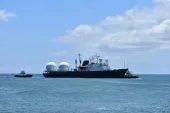
COUNTRY REPORT: From security to shortage: How will Taiwan free itself from regulatory chains?
Taiwan’s energy industry is revealed to be the product of an era that engages high-level regulation.
It may have made a name for itself in economic terms as it is slated to make a recovery in 2016, but Taiwan remains a notorious name in the regional power industry. Taiwan has very limited domestic energy resources and must rely on oil and coal imports to satisfy the majority of its energy demand.
According to Taiwanese official statistics, oil, coal, and natural gas made up 40%, 31%, and 17% of Taiwan’s total primary energy consumption in 2014, respectively, while the remainder was mostly nuclear (10%) and smaller amounts of various renewable energy sources. Total energy import dependence was about 98%, according to the Taiwanese government.
Its electricity supply system is also distinct. Power grids in many countries or regions are interconnected so that electricity costs can be lowered by reducing the need for generating capacity and by substituting expensive fuel for cheaper fuel, as well as by diversifying generation methods to minimise risks of supply and price volatilities. However, Taiwan’s insular geography means its power supply is isolated.
According to Ssu-Li Chang of National Taipei University, as a result of the lack of interconnectedness with other regions, the island requires much higher generation reserve margins than elsewhere in order to ensure reliability in the case of a transmission grid outage, to protect system safety, and to ensure continuous operation. “Furthermore, with a mandatory renewable electricity target of 8 percent by 2025, and with 50 percent of total renewables expected to come from wind power dependent on favorable weather conditions, there is likely to be more uncertainty in the operation of the power system,” she explains.
Taiwan’s supplies of primary energy are also highly concentrated on traditional fossil fuels, of which oil, natural gas and coal continue to be the dominant sources
In a paper entitled “Current Policy and Challenges of Energy Utilities in Taiwan” by Ju-Yin Chen, associate professor, Department of Law, Hsuan Chuang University, shows that by the market layout of power generation by Taiwan’s power industry, TaiPower accounts for 68%, the private power plants account for 16%, and the qualified cogeneration systems account for 16%.
“The private power plants and the cogeneration systems sell the power they produce to TaiPower, which then distributes the power to the end users. Therefore, TaiPower monopolises the power transmission, distribution and sale in the middle and downstream. Put simply, according to the current Electricity Act, the power industry in Taiwan is now composed of one state-owned integrated power company, several private power producers and self-use power generation equipment (including the cogeneration systems and the renewable energy generators),” she further says.
At present, the redundant power of the self-use power generation equipment and all the power produced by the cogeneration systems and private power plants are wholesaled to TaiPower for uniform distribution.
“From the layout of Taiwan’s power market currently, we can clearly see that TaiPower is the only integrated company in power generation, transmission and distribution, which is also responsible for supplying power to the users in Taiwan, Penghu, Kinmen and Matsu areas within the coverage scope. In case of insufficient power, it opens the Independent Power Producers (IPP) to construct power plants, which sign a 25-year contract with TaiPower, agreeing to wholesale all the power to TaiPower,” Ju-Yin clarifies.
The consequence of its power scheme
For the end users, they can’t choose to purchase power from a certain company. Ju-Yin explains that on the whole, the energy industry is directly related to the national economic development. Taiwan’s energy industry is particularly protected and has been managed by the government for a long time. In early times, it adopted the monopoly and state-owned operation method, so as to ensure the stable supply of various energy resources and to implement policies.
“However, it also resulted in corruption and inefficiency of the public enterprise. Under the global trend of internalisation, liberalisation and privatisation, Taiwan’s energy industry is gradually stepping into the open status to some extent, but some cases and experiences of market competition failure still occur,” she expounds. “As the strategies which government takes to regulate industries could be either direct control or a competition mechanism formed by the market, it is crucial for us to continue to observe Taiwan’s energy policy and see how it will develop in these conditions, to achieve the goal of maximum efficiency and consumer sovereignty.”
Can nuclear do the job?
Jonathan Cobb of the World Nuclear Association says that the solution to the energy market’s problems will need to make the best use of a wide range of generation and supply technologies, and that will include nuclear. “Nuclear power has a very important role to play through supplying electricity that is low carbon and can be delivered securely and reliably.”
The government plan calls for generating some 15% of domestic power from renewable sources by 2030. The target is to have in place 5,200 megawatts (MW) of installed wind power and 8,700 MW of installed solar photovoltaic (PV), as well as biomass-fueled power plants and even geothermal, for a total of 17.25 gigawatts (GW) of renewable energy installed capacity.
Timothy Ferry from the AmCham Taipei says that for its part, the DPP’s 2025 Nuclear Free Homeland Initiative, the blueprint for the party’s energy policy, calls for generating 20% of Taiwan’s total power from renewable energies by a decade from now.
But can renewable technologies such as wind power and solar PV provide enough electricity to offset the loss of nuclear power, while also allowing Taiwan to meet its emissions reductions commitments? Nuclear plants currently generate more than 38,000 GWh of electricity annually, making up 18% of Taiwan’s total power supply.
The scale of the challenge is enormous. Researchers at the Industrial Economics and Knowledge Center (IEK) under the Industrial Technology Research Institute (ITRI) estimate that to generate enough power to replace nuclear energy, Taiwan would need to install 55 GW of solar PV, requiring some 700 square kilometers of land.
“It’s quite difficult to replace nuclear power in the really short run, because we aren’t ready in terms of the whole infrastructure, and also the capacity of renewable energy is quite low right now,” says Wen Lih-chyi, director and research fellow at the Center for Green Economy at the Chung-Hua Institution for Economic Research. She adds that new energy technologies such as hydrogen fuel cells are “not really commercialised yet.”
Overcoming the challenges for real
Ju-Yin says that Taiwan’s energy industry is the product of era that engages high-level regulation, and so far the laws seldom think to reform the regulation system from the perspective of the consumer who is involved in the economic activities.
“The central power supply regulation model, as well as the top-to-bottom demand and supply model of energy has changed, whether it is for the petroleum, liquefied gas, natural gas or electricity industries. In the future, demand side management of energy saving and energy use will surely grant more rights to the consumers,” she argues.
Benjamin Fox, a former energy analyst intern at the US Department of Energy in Beijing, also writes that the environment-related challenges that Taiwan faces related to energy use and CO2 emissions are as serious or perhaps even more so than those of the U.S. Taiwan continues to rely on a higher proportion of fossil fuel than the U.S. As a result, it lacks any semblance of energy security and ranks amongst the world‘s highest per capita CO2 emitters.
“Due to its small population and murky political status, Taiwan is often overlooked in the realm of global affairs. But a rash of similarities with the U.S. in terms of economic, demographic, and political structure warrant its consideration in the field of sustainable energy policy,” he says.
In spite of these negative factors, Taiwan has passed multiple progressive policies that address energy efficiency, renewable energy installation, and the promotion of its domestic clean technology industry. The modest success of Taiwan‘s sustainable energy policy demonstrates the importance of setting short-term and mid-term goals, even if they initially generate suboptimal outcomes.
aIndeed, Taiwan‘s short-term and mid-term CO2 emissions and renewable energy targets are relatively conservative and fall well short of proposals pushed forth by the E.U. and other world leaders. However, Taiwan‘s modest goals have fostered important legislation and financial investment that provide important price signals to its burgeoning clean technology industry. “Thus, Taiwan‘s sustainable energy policy is the beginning of a process of reorienting Taiwan‘s economy towards the energy technology sector, enhancing its economic competitiveness, environmental health, and contribution to global climate change initiatives,” Fox says.



















 Advertise
Advertise






